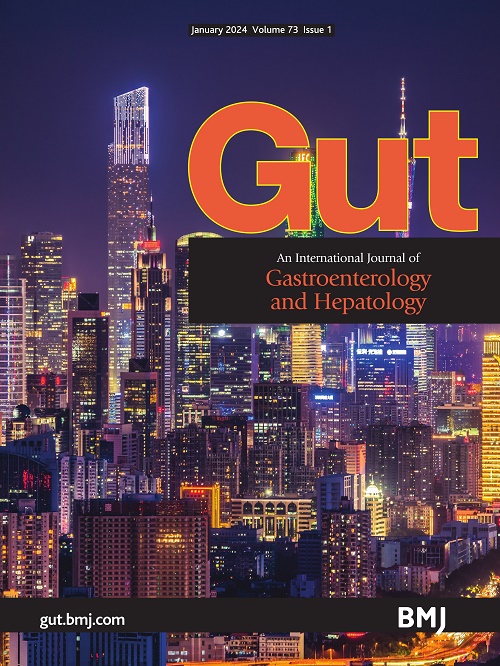胃肠道癌症流行病学:2021 年全球疾病负担研究的系统分析
IF 23
1区 医学
Q1 GASTROENTEROLOGY & HEPATOLOGY
引用次数: 0
摘要
背景 胃肠道癌症占全球癌症死亡率的近三分之一,但这些癌症对全球造成的综合负担仍未得到调查。目标 我们旨在评估全球、地区和国家的胃肠道癌症负担。设计 从《2021 年全球疾病负担》数据库中提取食道癌、胃癌、结直肠癌、肝癌、胰腺癌和胆道癌的数据。按性别、地区和社会人口指数(SDI)计算年龄标准化发病率(ASIR)和年龄标准化死亡率(ASDR)。结果 2021 年,胃肠道癌症的发病人数为 526 万,死亡人数为 370 万。结肠直肠癌造成的负担最大,其次是胃癌、食道癌、胰腺癌、肝癌和胆道癌。我们注意到,所有类型癌症的 ASIR 和 ASDR 都存在地域和社会经济差异。从 2000 年到 2021 年,结直肠癌的 ASIR 有所上升(年百分比变化 (APC):0.10%,95% CI):0.10%,95% CI 为 0.05% 至 0.14%)、胰腺癌(APC:0.27%,95% CI 为 0.14% 至 0.41%)以及代谢功能障碍相关性脂肪性肝病(APC:0.62%,95% CI 为 0.58% 至 0.67%)和酒精相关性肝病(APC:0.26%,95% CI 为 0.22% 至 0.30%)引起的肝癌的 ASIR 均有所增加。胰腺癌(APC:0.18%,95% CI 0.02% 至 0.34%)的 ASDR 有所上升。SDI 较高的国家在大多数类型的胃肠道癌症中发病率较高。结论 虽然食道癌、胃癌和胆道癌的 ASIR 有所下降,但结肠直肠癌、胰腺癌和脂肪肝引起的肝癌的 ASIR 仍在上升。公共政策对控制胃肠道癌症非常重要,其中最重要的是减少饮酒、乙型肝炎免疫接种和解决代谢性疾病的负担。数据可在公开、开放的资料库中获取。2021 年全球疾病负担(GBD)研究的数据可通过全球健康数据交换(GHDx)查询工具()获取。非商业性使用 GBD 数据无需获得许可。本文章由计算机程序翻译,如有差异,请以英文原文为准。
Epidemiology of gastrointestinal cancers: a systematic analysis from the Global Burden of Disease Study 2021
Background Gastrointestinal cancers comprise nearly one-third of global mortality from cancer, yet the comprehensive global burden of these cancers remains uninvestigated. Objective We aimed to assess the global, regional and national burden of gastrointestinal cancers. Designs Data on oesophagus, gastric, colorectal, liver, pancreas and biliary tract cancers were extracted from the Global Burden of Disease 2021 database. Age-standardised incidence rate (ASIR) and age-standardised death rate (ASDR) were calculated by sex, region and Sociodemographic Index (SDI). Results In 2021, there were 5.26 million incidences and 3.70 million deaths from gastrointestinal cancer. The greatest burden is from colorectal, followed by gastric, oesophageal, pancreatic, liver and biliary tract cancer. We noted geographical and socioeconomic differences in ASIR and ASDR across all types of cancers. From 2000 to 2021, ASIR increased for colorectal cancer (annual percent change (APC): 0.10%, 95% CI 0.05% to 0.14%), pancreatic cancer (APC: 0.27%, 95% CI 0.14% to 0.41%), and liver cancer from metabolic dysfunction-associated steatotic liver disease (APC: 0.62%, 95% CI 0.58% to 0.67%) and alcohol-related liver disease (APC: 0.26%, 95% CI 0.22% to 0.30%). ASDR increased for pancreatic cancer (APC: 0.18%, 95% CI 0.02% to 0.34%). Higher SDI countries had higher incidence rates for most types of gastrointestinal cancer. Conclusions Although the ASIR of oesophageal, gastric and biliary tract cancer has decreased, the ASIR still increased in colorectal, pancreatic and liver cancer from steatotic liver disease. Public policies are important for controlling gastrointestinal cancers—most importantly, reducing alcohol consumption, hepatitis B immunisation and tackling the burden of metabolic diseases. Data are available in a public, open access repository. Data from the Global Burden of Disease (GBD) study in 2021 can be accessed using the Global Health Data Exchange (GHDx) query tool () which the Institute for Health Metrics and Evaluation maintains. The GBD data do not require licensing for non-commercial use.
求助全文
通过发布文献求助,成功后即可免费获取论文全文。
去求助
来源期刊

Gut
医学-胃肠肝病学
CiteScore
45.70
自引率
2.40%
发文量
284
审稿时长
1.5 months
期刊介绍:
Gut is a renowned international journal specializing in gastroenterology and hepatology, known for its high-quality clinical research covering the alimentary tract, liver, biliary tree, and pancreas. It offers authoritative and current coverage across all aspects of gastroenterology and hepatology, featuring articles on emerging disease mechanisms and innovative diagnostic and therapeutic approaches authored by leading experts.
As the flagship journal of BMJ's gastroenterology portfolio, Gut is accompanied by two companion journals: Frontline Gastroenterology, focusing on education and practice-oriented papers, and BMJ Open Gastroenterology for open access original research.
 求助内容:
求助内容: 应助结果提醒方式:
应助结果提醒方式:


